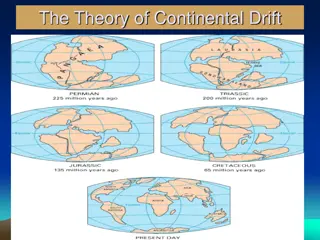Continental Drift, Theory of Tolerance & Major Biomes of the World Overview
This detailed presentation explores topics like Continental Drift, the Theory of Tolerance, and Major Biomes of the World. It covers the history of the Continental Drift theory, from Wegener to Du Toit's modifications, and delves into the various terrestrial biomes that exist, including tundra, boreal forest, deciduous forest, tropical rainforest, grassland, and desert.
Download Presentation

Please find below an Image/Link to download the presentation.
The content on the website is provided AS IS for your information and personal use only. It may not be sold, licensed, or shared on other websites without obtaining consent from the author.If you encounter any issues during the download, it is possible that the publisher has removed the file from their server.
You are allowed to download the files provided on this website for personal or commercial use, subject to the condition that they are used lawfully. All files are the property of their respective owners.
The content on the website is provided AS IS for your information and personal use only. It may not be sold, licensed, or shared on other websites without obtaining consent from the author.
E N D
Presentation Transcript
Continental Drift, Theory of Tolerance & Major Biomes of the World Dr Habibur Rahman Associate Professor J. N. College, Boko
Topics covered: 1.Continental Drift 2.Theory of Tolerance 2. Major Biomes of the World
Continental drift First proposed by Wegener (1915) According to this theory, there existed a single huge landmass Pangea /Pangaea supercontinent. It existed during late paleozoic and early mesozoic era. In late mesozoic and coenozoic era, it broke up and by drifting of its fragments, the ocean opened up.
Continental drift Du Toit (1937) proposed modifications and refinement of this theory. He suggested occurrence of 2 primordial continents: 1. Laurasia The Northern landmass and 2. Gondwana (Gondawanaland)- the Southern landmass Separated by Tethys sea The occurrence of these two landmasses is supported by Glossopteris flora
Biome Definition: plants and animals that make their homes there. Biomes contain many ecosystems within the same area. Land-based biomes are called terrestrial biomes. Water-based biomes are called aquatic biomes. Temperatures, precipitation amounts and prevalent organisms characterize the biomes of the world. Biomes are named and categorized based on the climate, plants and animals that exist there. 6 major terrestrial (land) biomes tundra, boreal forest, deciduous forest, tropical rainforest, grassland, desert A biome is a large area of land that is classified based on the climate,
Major Biomes of the World 8 Major Terrestrial (land) Biomes: 1. Chaparral Biome 2. Tundra 3. Boreal forest 4. Deciduous forest 5. Tropical rainforest 6. Grassland 7. Desert 8. Alpine
1. Chaparral Biome Scrubland and few trees characterize chaparral. Chaparral receives between 25 and 30 inches of rain annually, chiefly in winter. Dry summers mean dormancy for many plants. Chaparral can be found throughout southern California and Baja, Mexico.
2. Desert Biome It receive less than 12 inches of precipitation annually and experience very high temperatures. Desert subtypes include hot and dry, semiarid, coastal and cold (Arctic). Extremely little rain yearly: more evaporation and transpiration (sun pulling water from leaves) than precipitation. No seasons, temperatures change with night and day. Very dry and hot during day and cold at night Sahara Desert is the largest desert in the world. It s bigger than the whole United States and it s still growing
2. Desert Biome Cacti, aloe plants, sagebrush, lizards, camels, snakes, spiders, scorpions, chameleons, birds, reptiles, armadillos etc. Adaptations for plants and animals to live here: Animals have sandy colored skin, fur, and scales for camouflage, reptiles have thick scaly skin to keep water inside their bodies, large ears and long legs to release heat during the day, able to go for long amounts of time without drinking water or can store up water; Plants have a large root system that soaks up water very quickly when it rains, waxy coating covers plants and protection with thorns to keep water inside them. Example: the Mojave Desert of the American Southwest.
3. Tundra Biome Permafrost permanently frozen soil, covers the land frozen soil stops trees from growing Very cold, dry, and windy climate; like a cold desert. Gets only a little more precipitation a year than a desert does. Yearly temperatures stay mostly below freezing except for the short spring/summer/fall season that lasts 3 months total. Some plants live their entire life span in this time. Mostly in spring/summer/fall flowers, grasses, lichen, ducks, geese, shore birds, weasels, arctic foxes, squirrels, caribou, mosquitoes, lemmings, mice, polar bears, penguin. Adaptations for plants and animals to live here: Animals: white fur for camouflage, thick fur for warmth, black skin under their white fur to help trap heat, short logs and small ears to keep heat from escaping their bodies, hooves to dig through the permafrost to find food; Plants have shallow roots because soil stays frozen, grow quickly because summer is very short. Example: the High Arctic Tundra in the islands of the Arctic Ocean.
4. BOREAL FOREST or Taiga Biome: (Coniferous forest, Evergreen forest, Taiga) Conifer triangular shaped tree that has needles for leaves, stays green all year long, and covers its seeds with cones Summers are very short and warm with winters being cold and lasting almost half the year. Some precipitation, but not a lot and it falls mostly as snow in the winter. The soil thaws completely in spring and parts of the forest become like a swamp; also known as a swampforest which is what taiga means in Russian Too cold more many decomposers so things tend to stay on the forest floor for a long time making the soil less fertile than the other forests; less sunlight due to tilt of Earth so plants can be small and die quickly if they don t grow fast Spruce, pine, Douglas fir, moose, beavers, lynx, snowshoe hare (rabbits), weasels, squirrels, wolves, birds, elk, otter Adaptations for plants and animals to live here: Animals: thick fur for warmth, white fur in the winter and brown fur in the summer for camouflage, hibernate during winter when plants go dormant and there is little food, hooves to dig through the snow pack and get to buried plants; Plants grow quickly because summer is very short, trees have needles to keep moisture inside them and are cone shaped to let snow slide off them
5. Rainforest Biome The tropical rainforest biome contains the world s greatest biodiversity. Located near the equator, this biome experiences equal day length, warm temperatures and up to 200 inches of rain annually. These conditions lead to prolific plant growth in levels from the forest floor to the canopy. Epiphytic plants grow on trees and other vegetation. The Amazon Rainforest is an excellent example of a tropical rainforest biome. Temperate rainforests are found in higher latitudes, with cooler temperatures but significant amounts of precipitation. Evergreens, mosses and ferns thrive there. The Olympic National Park of Washington State hosts temperate rainforests.
TROPICAL RAINFOREST (Jungle, Rainforest) Canopy tops of trees 30-50 meters above the ground Understory second layer of shorter trees and vines; about 20-30 meters above ground Very humid climate because it rains almost every day. Plants have a lot of water and grow tall. Very little plants and animals live on the forest floor because the canopy doesn t let much light through. Most plants and animals live in the canopy. Has more varied plant life than any other biome and very poor soil for growing crops. Highest levels of precipitation of all biomes rains daily; temperatures stay warm (80 F) all year round no seasons Trees, ferns, vines, fungi, orchids, insects, birds, monkeys, jaguars, frogs, snakes, eagles, bats, snakes, spiders, ants, beetles, sloths, etc. Adaptations for plants and animals to live here: Animals have arms, hands, and feet to climbing so they can live in the canopy, long strong tails to help climb and balance when living on tree branches; Plants grow quickly and reach the top of the canopy where there is sunlight, plants under the canopy have large leaves to collect sunlight and grow quickly, some plants get nutrients by eating insects instead of getting nutrients from the soil since there are very few nutrients in the soil.
6. Grassland Biome (Tropical Savannah; Temperate Prairie, Plains): Grasslands represent biomes dominated by grass. The hot, tropical Savannah takes up nearly half of Africa as well as parts of India, South America and Australia. Monsoon massive rain storm in tropical grassland where it rains for weeks straight Overgrazing farmers grazing animals in an area too much and killing all the grasses Grasslands become deserts when farmer overplant or overgraze the land. Two seasons wet and dry. In the wet season it rains all the time and floods out the tropical grassland area. Temperate grassland get blizzards instead of monsoons. The dry season gets no rain or snow at all. Cold winters and warm summers. Tropical grasslands are hotter in the summer than temperate grasslands because they re closer to the equator.
6. Grassland Biome Temperature grasslands have the best soil for growing crops. Called breadbasket here in US since most of the wheat and grain for making bread is grown here. Home to the largest land animals mostly herbivores Grasses, small trees and shrubs, antelope, zebra, giraffe, lions, elephants, ants, wild dogs, cheetahs, mice, rats, snakes, hawks, rabbits, eagles, vultures, hyenas, prairie dogs Adaptations for plants and animals to live here: Animals are striped/patterned to blend in with grasses and shrubs, quick runners to catch fast prey or outrun predators, release heat during the day from large ears and long legs, large land herbivores live in packs/herds to keep themselves safe from predators; Plants have wide spread roots to catch water in dry season, grow fast, store water, some with thorns for protection.
7. DECIDUOUS FOREST BIOMES (Temperate-mild forest) Deciduous plants that drop their leaves in autumn (fall) Dormant when plants have lost their leaves and shut down for the winter due to less sunlight Four equal seasons (spring, summer, winter, fall) with average amounts of precipitation all year Summers are hot and winters cold. Trees losing their leaves in the fall makes for very good growing soil. It s the second best. Oak, maple, beech trees, ferns, wild flowers, fungi, squirrel, deer, owl, spiders, birds, snakes, snails, insects, worms, mice, raccoon, frogs, salamanders, rabbits, chipmunks, opossums. OUR BIOME we live here Adaptations for plants and animals to live here: Animals adapted for all four seasons by growing thick fur in the fall/winter and shedding their fur in the spring/summer, hibernation or migration; Plants lose their leaves and go dormant during the winter to keep from losing water through transpiration during the cold winter.
Temperate deciduous forests populate eastern North America, central Europe and northeastern Asia. Distinct seasons, consistent precipitation and varied temperatures yield a diverse biome. Deciduous broadleaf trees, evergreens and other plants flourish. This biome hosts many animal species including deer, rabbits, bears, birds, insects and amphibians. Example: Great Smoky Mountains National Park.
8. Alpine Biome The mountainous alpine biome exists only at high altitudes. At those levels, trees do not grow. Alpine regions receive about 180 days of growing season. A number of shrubs, grasses and heaths thrive. Mammals such as sheep, elk, goats and pikas flourish. Some bird species and several types of insects live there. Example: the high Sierra Nevada mountain range in California.























